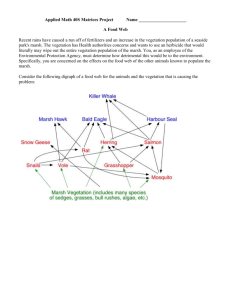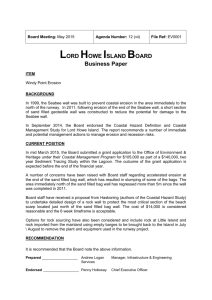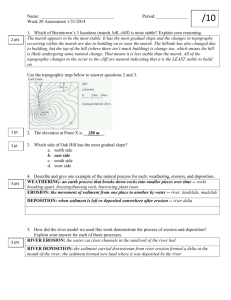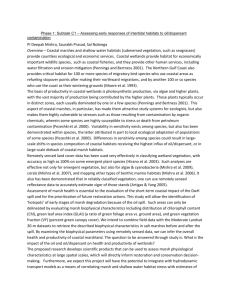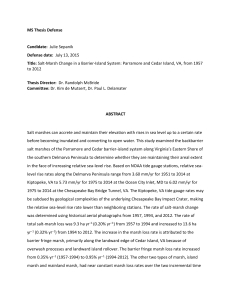coastal wetlands - Florida Department of Environmental Protection
advertisement
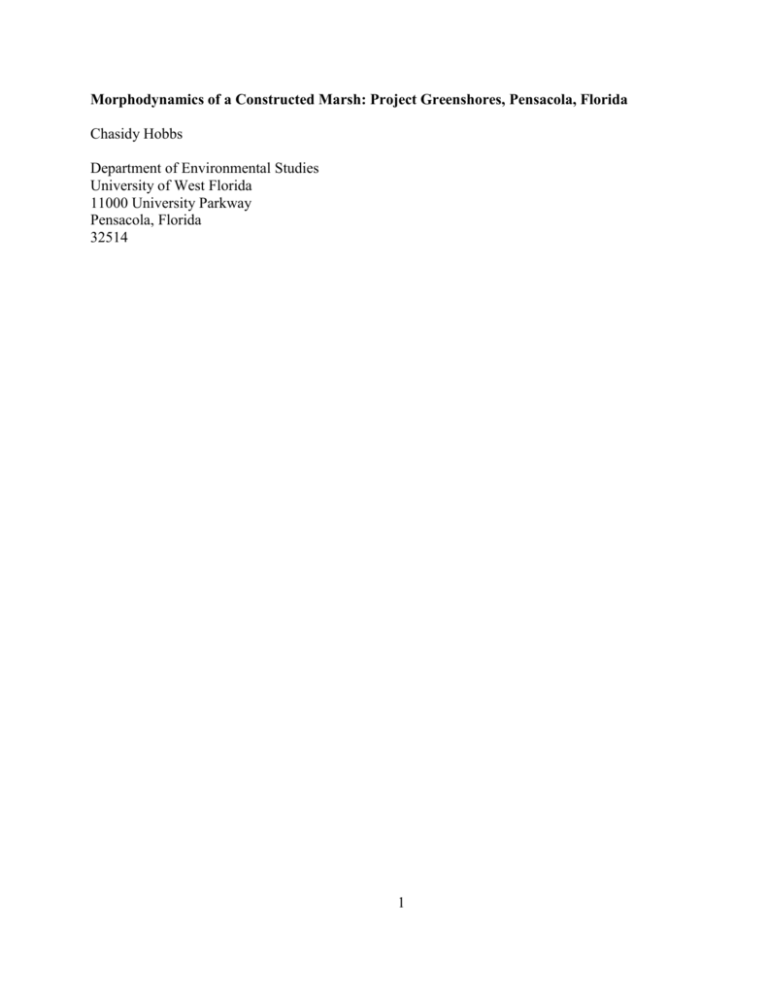
Morphodynamics of a Constructed Marsh: Project Greenshores, Pensacola, Florida Chasidy Hobbs Department of Environmental Studies University of West Florida 11000 University Parkway Pensacola, Florida 32514 1 Abstract Project Greenshores, an ecosystem restoration project in Pensacola, Florida, was established on a barred nearshore terrace to provide local marsh and seagrass habitat along the now highly developed shoreline. The project included the placement of dredge material in a series of islands and the establishment of submergent and emergent grasses fronted by oyster reefs. While the establishment of the marsh alone was considered an important success, the long-term stability of this project, and most designed environments in general, is not clear. This study examines the morphological response of the center island to a sequence of storm events from July 2005 to July 2006. Morphological change was monitored using erosion pins and related to elevation, inundation period, and vegetation density and height using correspondence analysis, a nonparametric test for association amongst nominal data. Over the course of the study, which included Hurricanes Dennis and Katrina, the island migrated landward to the north-northwest. The observed pattern of sedimentation and erosion and its relationship to the inundation period, vegetation characteristics and elevation varied through the growing season. The relatively simple erosion-deposition couplet observed is more characteristic of a cross-island shoaling and attenuation of wave energy during storms. In this respect, the morphological change is likened to that of an intertidal bar rather than that of a natural marsh. It is reasonable to expect that the island will continue to continue migrate landward during storm events and potentially connect to the mainland. 2 1. INTRODUCTION Coastal wetlands are complex ecosystems that, in general, serve as a defense for coastlines by binding deposited sediments and dissipating wave and current energies (ADAMS, 2002; BROOME, SENECA, and WOODHOUSE, 1986; LEONARD and LUTHER, 1995; SILANDER and HALL, 1997; VAN DER WAL and PYE, 2004). Wetlands also filter freshwater flowing from land to sea (WOLANSKI et al., 2004), are valuable nursery grounds for aquatic organisms (ADAMS, 2002; SACCO et. al., 1994), and provide food and habitat for many land and aquatic species (WOLANSKI et al., 2004). Natural salt marshes form in low energy estuarine environments, once sufficient accretion has occurred to allow for emergent halophytes on mudflats and/or sandflats (DAVIDSON-ARNOTT et al., 2002). Several factors influence the morphological progression of coastal marshes, for example: elevation (PETHICK, 1981; SENECA, BROOME, AND WOODHOUSE, 1985), proximity to sediment sources (STODDART, REED, and FRENCH, 1989), local plant communities (STUMPF, 1983), tidal range (HARRISON and BLOOM, 1977), organic accumulation rates (CALLAWAY, DELAUNE, and PATRICK, 1997; TURNER, SWENSON, and MILAN, 2000), sea level rise (DONNELLY and BERTNESS, 2001; ORSON, PANAGEOTOU, and LAETHERMAN, 1985; REED, 1995; STEVENSON, WARD, and KEARNEY, 1986), and inundation period (PETHICK, 1981). Marsh accretion is usually associated with tidal creeks (LAWRENCE, ALLEN, AND HAVELOCK, 2004; WANG, SIKORA, and WANG, 1994; LEONARD et al., 1995; REED, 1988; TEMMERMAN et al., 2005), which not only provide sediment but also nutrients essential for health (REED, 1988). In marshes that lack riverine inputs, sediments are usually associated with the re-suspension of nearby estuarine sediments, and accretion depends on the hydroperiod (CAHOON and REED, 1995; TEMMERMAN et al., 2005). In general, longer inundation periods lead to higher accretion rates (Stevenson et al., 1986) leading to a complex feedback between sedimentation, elevation and vegetation zonation. From 1950 to the mid 1970s, the United States lost coastal wetlands at an average rate of nearly 500,000 acres per year (CIUPEK, 1986). To offset the impact of this wetland loss, there have been several initiatives including nationwide wetland restoration projects. One such undertaking is Project Greenshores (Figure 1), one of the largest ecosystem rehabilitation projects in northwest Florida led by Florida Department of Environmental Protection's (FDEP) 3 Ecosystem Restoration Laboratory. The project entails the establishment of an oyster reef, seagrasses and a Spartina alterniflora salt marsh within Pensacola Bay. Greenshores was also constructed to filter sediments and pollutants from a large stormwater outfall that drains a mixeduse development area of Pensacola, Florida, in hopes of improving the water quality of the 303(d) listed Pensacola Bay. Similar to the Ria Formosa lagoon in Portugal (NEUMEIER and CIAVOLA, 2004) Pensacola Bay can be characterized as having little to no wave action except during extra-tropical storms and high suspended sediment events during winter storms. Without tidal creek systems, the source of sediment for Greenshores, comes from both runoff and stormwater outfalls along with re-suspended sediments within the bay. Greenshores provides essential habitat and shoreline protection during storms; however the stability of the created marsh islands has not been investigated. Project Greenshores is being completed in two phases. Phase I, which is the study site of this research, was completed in the 2003 (with a small replanting event in the summer of 2004). When Phase I of the project was started, the sub-littoral zone was a barred terrace with no emergent or aquatic vegetation. The area offered very little valuable habitat, an element crucial to local commercial fisheries, including the local shrimping industry, which harvests within Pensacola Bay. As part of this phase of construction, 8 acres of salt marsh and seagrass beds were planted on ~27,000 cubic meters of dredge material. Approximately 40,000 S. alterniflora and 3,900 locally propagated seedlings of Ruppia maritime, were planted on 5 intertidal islands (Islands I – V) just offshore (Figure 1). Since the islands have a maximum elevation of .37 m (at the start of this study) and the tidal range in Pensacola Bay is ~0.50 m, the islands can be considered intertidal features. In addition, 7 acres of oyster reefs were constructed seaward of the islands with 14,000 tons of Kentucky limestone, 6,000 tons of recycled concrete and 40 wave attenuators. The surfaces of these reefs were covered with oyster shells recycled from local restaurants. As breakwaters, these reefs not only provide protection for the newly planted vegetation and dredge spoil, but they also create habitat for the propagation of new oysters. While considerable effort and expense is put into the development of a constructed wetland, little attention is paid to the long-term stability of these environments, particularly where wetlands (such as Project Greenshores) are placed in environments that were not 4 historically wetlands. ZEDLER and CALLAWAY (2000) suggest a lack of topographic complexity, soil organic content and nutrients, excessive sedimentation and erosion and contamination during wetland creation as common limitations of constructed environments. Also, as suggested by Craft, et al. (1988) it takes anywhere from 15 to 30 years for macro-organic matter nutrient pools to develop and considerably longer for soil carbon, nitrogen and phosphorus reservoirs to accumulate. ZEDLER and CALLAWAY (2000) further note that more science-based research and post-construction monitoring be incorporated into restoration projects in order to allow for quicker development of successful restoration practices, improved assessment methods and an enhanced understanding of the functions of both natural and restored ecosystems. In order to determine if a constructed environment is stable (and can be deemed a success), it is important that the system and the environmental forcing (such as waves, currents and inundation regime) be monitored. While it is generally understood that marsh plants will influence and force the sedimentation and erosion patterns, this depends on the incident wave and current energy, along with a complex and poorly understood feedback created by changes in elevation, inundation period, and the distribution of vegetation. Project Greenshores is locally considered a “success” based on the original construction goals, but the morphological stability of the project is unclear. This paper reports on a monitoring study at Project Greenshores to determine the degree, if any, vegetation, inundation period and elevation influence morphological change and potentially force stability in this dredge spoil marsh. 2. METHODS Island III was nominally chosen as the focus of this study due to its location in the center of the project and also due to it being the largest in size. In this respect, the results of this study are not necessarily applicable to the other islands or Phase II of the project. At the onset of the study, a differential GPS was used to map the perimeter of Island III (which corresponds with the vegetation perimeter), and this was used to define a systematic grid for morphological and vegetation sampling on the island. 2.1 Morphological Response 5 Erosion pins, or perhaps more accurately called elevation rods, provided an inexpensive and reasonable means to characterize the morphological response (patterns of erosion and accretion) of Island III over the course of this study. Elevation rods have been used in a number of studies to determine patterns of accretion and erosion (morphological change) in the nearshore (HOUSER, GREENWOOD, and AAGAARD, 2006; KING, 1951), on foredunes (ARENS, 1996;ARENS et al., 2001) and in coastal marshes (CARLING, 1982; REED, 1988). Sixty-eight elevation rods were placed in a grid pattern throughout the island and the grid pattern was composed of 10 cross-island transects. The elevation at each elevation rod (sample points) at the beginning of the three periods (discussed further in the vegetation analysis section) was determined using a combination of a total station survey performed on December 13, 2005 and the morphological change measured by the elevation rods. By the end of the study, two of the rods were bent and six were covered with oysters, both of which complicated measurement and increased measurement error. Due to this, data from 8 erosion pins were removed for all analyses and only those 60 remaining sampling points will be discussed further. 2.2 Inundation The local tidal variation was obtained from a NOAA station (Station ID: 8729840) located approximately 1.8 km alongshore from Project Greenshores. The inundation period at each sample point was calculated based on the relative elevation of the erosion pin and the tide level. This method of determining inundation period represents the minimum-flooding regime, as it does not take into account ponding effects brought on by the local microtopography (REED and CAHOON, 1992). Wind speed and direction, and atmospheric pressure were obtained from the same NOAA station. At the start of the study, wave heights were measured at a number of locations at the study site, but the incident wave field generated by the oyster reefs and breakwaters were overly complex and an appropriate spatial sampling strategy could not be developed with available sampling equipment. 2.3 Vegetation Analysis Given that variations in vegetation demographics will affect the pattern of erosion and sedimentation (FRENCH, et al., 1995; LEONARD and LUTHER, 1995; REED et al., 1999), the study 6 was divided into three periods assumed to have similar vegetation characteristics: Period 1 (July 7, 2005 to November 8, 2005), characterized by summer storms and the end of the growing season; Period 2 (November 9, 2005 to February 28, 2006), characterized by winter cold fronts and the dieback of the Spartina from the previous period; and Period 3 (March 1, 2006 to July 19, 2006), characterized by a calm spring growing season. A non-invasive vegetation survey was performed during each period (on September 1, 2005, January 12, 2006, and May 5, 2006). A 1 m2 frame made from pvc pipe was used for the vegetation surveys and was centered on each of the 60 elevation rods. Vegetation density was recorded as the total number of standing shoots at a height of 10 cm above the bed, and plant height was determined by an average of ten random measurements from the bed to the extent of live shoot (KASWADJI, GOOSELINK, and TURNER, 1990; LASALLE, LANDIN, and SIMS, 1991; LEONARD and LUTHER 1995; NEWLING, 1981; REICE and STIVEN, 1983; WEBB and NEWLING, 1985). 2.4 Relationship Analysis Inverse distance weighted (IDW) interpolation was used to create raster surfaces for each of the studied variables within each of the 3 study periods. IDW is based on the assumption that nearby values of known points influence the value of an unknown point and the weight of this influence diminishes as distance between points increases. The interpolated surface is therefore, a weighted average of values based on known points. The weight each known value has on an unknown point is defined by the power of the relationship. Small powers allow for an even distribution of weight across all known values; as power increases more weight is put on closer known values. IDW was chosen due to the fact that the spatial variation in the data was assumed to be heterogeneous and unknown values were closer related to nearby known values. Correspondence Analysis (CA) has commonly been used in the study of ecology; see for example, GAUCH (1982). CA is a non-parametric test, which allows for several discrete variables – nominal, ordinal, or continuous (broken into segmented ranges) – and analyzes associations among these variables. This statistical test is a variation of Principal Component Analysis; however, this test is tailored to categorical, rather than linear, data. CA uses Chi-square distances (rather than Euclidian distance) to arrange the variables (beginning elevation, morphological change, inundation period, and vegetation density and height), relative to an axis in 7 multidimensional space, according to their similarity (or association) to each other (CLAUSEN, 1998). Drawing a line from the origin to the plotted position of each variable and comparing the angle between these plotted positions determines associations among variables. The closer the angle is to 0 (positive correlation) or 180 (negative correlation), the stronger the relationship. Angles near 90 and 270 show little to no relationship between variables. Since correspondence analysis uses categorical data, morphological change was categorized as either accretion or erosion. All other variables were split into three ranges based on natural breaks in the histogram of all data collected for each variable: tall (> 1 m), average (0.5 – 1 m) and short (< 0.5 m) for height; dense (> 200), average (100 – 200) and sparse (< 100) for density; rare (< 33%), moderate (33 – 66%) and frequent (> 66%) for inundation and low (< 0.3 m), average (-0.3 – 0 m) and high (> 0 m) for beginning elevation. 3. RESULTS Island III has a continuous ridge that runs along the center of the island (east/west and closer to the seaward side of the island) that decreases in width at a small channel near the middle of the island. The channel was wide at the beginning of the study and nearly split the island in two; although, a small, vegetated area south of the channel connected both sides of the island. The channel began to fill in with both sand-sized sediment and vegetation over the remainder of the study, especially after Hurricane Katrina when a large sheet of plywood was deposited in the channel and became part of the bed. Overall, the island migrated to the northnorthwest as sediments eroded from the seaward side were deposited along the back of the island (Figure 2). As shown in Figure 3a, sediment was removed from the front (or southern edge) of the island during Period 1, and sediment accreted on the back of the island. In total there was an average accretion of ~3 mm during this period characterized by summer storms (including Hurricanes Dennis and Katrina) and the end of the growing season. Period 2 had no systematic variation in erosion and accretion (Figure 3b), although there was an average accretion of ~ 8 mm during this period of winter cold fronts. In contrast to the previous periods, during Period 3 (Figure 3c) the island lost an average of ~3 mm in elevation in response to erosion along most of the periphery. Over the course of the study the average elevation change was 8 mm accretion. There was no statistical difference at the 95% confidence level between the change that occurred 8 during Periods 1 and 2 (p = 0.27) nor for Periods 1 and 3 (p = 0.23). However, there was a statistical difference between the morphological change of Periods 2 and 3 (p = 0.01). 3.1 Inundation Period 1 was characterized by relatively high water levels, in response to the low pressure and storm surge generated as Hurricanes Dennis, Katrina, Rita and Wilma which passed through the area or in the Gulf of Mexico. While the prevailing (modal) wind during Periods 1 and 2 were from the north (southwest for Period 3), the strongest winds (greater than 7.5 m s-1) for all three periods were from the southeast. During this period of generally elevated water levels.During Period 1, waves were observed to both break on the leading edge and propagate over the island. Period 2 was associated with the passage of 12 cold fronts; in Pensacola Bay winter cold fronts first bring strong southerly winds, which “push” water in from the Gulf of Mexico and stir up available sediments through increased wave activity, which in turn increases turbidity of Pensacola Bay. As these fronts pass winds shift from the north and depress water levels within Pensacola Bay. Visual observations suggest that during these periods of depressed water levels and increased turbidity, waves generally break on the island. During Period 3 there was very little storm activity and inundation generally occurred only with tidal cycles. Periods 2 and 3 were statistically different in their beginning elevations at the 95% confidence level, and all three periods had statistically different inundation periods. Period 1 had the longest inundation period (~ 82%) while Period 2 had the shortest inundation period (~ 54%) and Period 3 had an intermediate inundation period (~ 65%). 3.2 Vegetation Analysis Since Period 1 incorporated the end of the growing season it was characterized by the tallest vegetation; a total of 4215 plants were found with an average height of 0.52 m at the 60 sample points. While Period 2 had the greatest density of vegetation due to the fact that the previous season’s plants were still standing and there was also new growth, particularly towards the end of the period. Due to the dieback and new growth, Period 2 had an average plant height of 0.25 m and a total of 8074 plants counted at the time of the survey. Period 3 had intermediate vegetation height and density; there were a total of 6807 plants at an average of 0.4 m height. 9 There was a statistical difference between all three periods for both plant height and plant density at the 95% confidence level. 3.4 Relationship Analysis Correspondence Analysis was used to examine the relationship between the morphological change (accretion/erosion), vegetation height and density, elevation and inundation period. As noted, the closer the angle on the correspondence plot is to 0 (positive correlation) or 180 (negative correlation), the stronger the relationship. Angles near 90 and 270 show little to no relationship between variables. As shown in Figure 4, Period 1 showed a strong positive association between erosion, high elevation, moderate inundation and average density. Accretion tended to occur at points that were frequently inundated but had a low density of vegetation. There were no areas with dense vegetation so this variable is missing from the analysis. During Period 2, erosion tended to be in areas with low elevation (leading to frequent inundation) and sparse vegetation (Figure 5). Consistent with the results of the morphological change, accretion was well-distributed on the island and equally distributed between areas of differing inundation. Accretion was more closely associated with an average vegetation density, although a moderately strong relationship was observed between sites with accretion and those with dense vegetation. During Period 3, sites with accretion tended to be weakly associated with high elevation, and short vegetation of average and high density (Figure 6). Consistent with Period 2, sites with erosion tended to be associated with low elevation with sparse vegetation. 4. DISCUSSION Prior to the establishment of Project Greenshores, the site was a barred nearshore terrace, which suggests that there was some level of local wave energy approaching the shoreline (MASSELINK et al., 2006) prohibiting natural marsh development. To reduce incident wave energy, breakwaters were emplaced to increase the potential that the dredge spoil marsh would be stable. Although the breakwaters dissipate incident wave energy through breaking, waves can pass unbroken into the area during storm surge and refraction and diffraction around the structures greatly complicates the wave field. This complicated wave field precluded the use of 10 the limited wave recorders available for this study, although waves were largely focused along the southern periphery of the island. Since only sand-sized material, or similar quality and size to the dredge material, was observed in those areas that experienced accretion it can be concluded that the morphological change was associated with a redistribution of the island material by the incident waves. It appears that there is no appreciable amount of fine sediment or other local sediment introduced to the island during storm events. In this respect, the island is not truly accreting and building as suggested by the elevation data. While it is generally assumed that vegetation density and height contribute to sedimentation through form drag, the results of this study suggest that erosion and sedimentation are more closely associated with both location on the island and the levels and patterns of inundation. Period 1 experienced ~ 3 mm accretion and had the longest inundation period (~ 82%) with the tallest and fewest plants. Period 2, which experienced the highest accretion levels (~ 8 mm), had the lowest inundation period (~ 54%), and the densest and shortest vegetation characteristics. Period 3, which was characterized by a general erosion pattern (~3 mm), had a slightly higher than average inundation period (~ 65%) and medium vegetation density and height. During Period 2, erosion was only observed in those areas that experienced frequent inundation, while accretion tended to occur in areas of both moderate and low levels of inundation. While the island was inundated more frequently during Period 1, the vegetation was relatively well established compared to Period 3, which had more erosion and smaller vegetation. In contrast, Period 2 was characterized by several cold front passages, but had the shortest inundation period (average 54%). Most wave activity during this period was attenuated by the fronting breakwater creating a choppy and complex wave field at the study site. In response to the smaller waves, most of the island experienced accretion, with a spatially averaged accretion of ~1cm. These results support the interpretation that the pattern of erosion and accretion are related to the transformation of sediment on the island. Sediment entrained along the leading edge of the island is transported to the back of the island, leading to the development of the center ridge. The transport gradients are not associated with vegetation density and height, but 11 rather are a response to wave transformation across the island. In this respect, the dredge spoil is more akin to a slowly migrating intertidal bar than it is to a natural marsh. As noted, this marsh was created on a barred terrace and the morphological progression of Island III appears to be more characteristic of an intertidal bar or barrier island than that of a typical salt marsh. Although the breakwaters dissipate some incident wave energy, they also greatly complicate the wave field around the islands through the processes of diffraction and refraction. This change in the incident wave field, along with natural season variability, may explain why landward migration is not evident during the entire study. Should environmental forcing factors influencing this island during the study period continue relatively unchanged for years to come, it is possible that the island(s?) may connect to the mainland in the future. Whether or not this constructed marsh is stable depends partly on ones definition of stability. Due to the construction design and island placement, it seems natural that Island III is migrating towards a place of equilibrium. Or, in other words, to a zone which natural historical marshes would have existed (landward). Considering Island III accreted on average, the resource is not being lost; it is simply migrating. Therefore, if one allows for migration within the definition of stability, it is concluded that Island III is stable. On a final note, it is suggested that further restoration projects be designed to more closely mimic natural shorelines in the region. If the process of migration were not incorporated into the history of this particular created marsh it would be several years closer to acquiring organics nutrients and developing more as a natural marsh, rather than this process being put on hold until the point of equilibrium is reached through migration. 12 Fig. 1. Phase I Project Greenshores, Pensacola, Florida 13 Fig. 2. Morphological change for the entire study period based on cut/fill analysis of inverse distance weighted interpolation surfaces. 14 Fig. 3a. Morphological change during Period 1. White represents areas of accretion while black represents areas of erosion. Fig. 3b. Morphological change during Period 2. White represents areas of accretion while black represents areas of erosion. 15 Fig. 3c. Morphological change during Period 3. White represents areas of accretion while black represents areas of erosion. Fig. 4. Correspondence Plot for Period 1. 16 Fig. 5. Correspondence Plot for Period 2. 17 Fig. 6. Correspondence Plot for Period 3. 5. REFERENCES Adams, P., 2002. Salt marshes in a time of change. Environmental Conservation, 29(1), 39-61. Arens, S.M., 1996. Patterns of sand transport on vegetated foredunes. Geomorphology, 17, 339-350. Arens, S.M,; Baas, A.C.W.; Van Boxel, J.H., and Kalkam, C., 2001. Influence of reed stem density on foredune development. Earth Surface Processes and Landforms, 26, 1161-1176. Broome, S.W.; Seneca, E.D., and Woodhouse, W.W. Jr., 1986. Long-term growth and development of transplants of the salt-marsh Grass Spartina alterniflora. Estuaries 9(1), 63-74. Cahoon, D.R, and Reed, D.J., 1995. Relationships among marsh surface topography, hydroperiod, and soil accretion in a deteriorating Louisiana marsh. Journal of Coastal Research, 11(2), 357-369. Callaway, J.C.; DeLaune, R.D., and Patrick, W.H., 1997. Sediment accretion 18 rates from four coastal wetlands along the Gulf of Mexico. Journal of Coastal Research, 13(1), 181-191. Carling, P.A., 1982. Temporal and spatial variation in intertidal sedimentation rates. Sedimentology, 29, 17-23. Ciupeck, R.B., 1986. Protecting wetlands under the Clean Water Act 404: EPA’s conservation policy on mitigation. National Wetlands Newsletter, 8, 12-15. Clausen, S.E., 1998. Applied correspondence analysis: an introduction. Sage University Papers Series on Quantitative Applications in the Social Sciences, 07-121. Thousand Oaks: Sage. Davidson-Arnott, R.G.D.; Proosdij, D.V.; Ollerhead, J., and Schostak, L., 2002. Hydrodynamics and sedimentation in salt marshes: examples from a macrotidal marsh, Bay of Fundy. Geomorphology, 48, 209-231. Donnelly, J.P. and Bertness, M.D., 2001. Rapid shoreward encroachment of salt marsh cordgrass in response to accelerated sea-level-rise. Proceeding of the National Academy of Sciences of the United States of America, 98(25), 14218-14223. French, J.R.; Spencer. T.; Murray, A.L., and Arnold, N.S., 1995. Geostatystical analysis of sediment deposition in two small tidal wetlands, Norfolk, U.K. Journal of Coastal Research, 11(2), 308-321. Harrison, E.Z. and Bloom, A.L., 1977. Sedimentation rates on tidal marshes in Connecticut. Journal of Sedimentary Petrology, 47, 1484-1490. Houser C.; Greenwood, B., and Aagaard, T., 2006. Divergent response of an intertidal swash bar. Earth Surface Processes and Landforms 31, 1775-1791. Kaswadji, R.K.; Gooselink, J.G.; and Turner, R.E., 1990. Estimation of primary production using five different methods in a Spartina alterniflora salt marsh. Wetlands Ecology and Management, 1(2), 57-64. King, C.A., 1951. Depth of disturbance of sand on sea beaches by waves. Journal of Sedimentary Petrology, 21(3), 131-140. Lasalle, M.W.; Landin, M.C., and Sims, J.G., 1991. Evaluation of the flora and fauna of a Spartina alterniflora marsh established on dredged material in Winyah Bay, South Carolina. Wetlands, 11(2), 191-208. Lawrence, D.S.L.; Allen, J.R.L., and Havelock, G.M., 2004. Salt marsh morphodynamics: an investigation of tidal flows and marsh channel equilibrium. Journal of Coastal Research, 20(1), 301-316. Leonard, L.A.,; Hine, A.C.; Luther, M.E., and Weight, E.E., 1995. Sediment transport processes in a west-central Florida open marine marsh tidal creek—The role of tides and extra-tropical storms. Estuarine Coastal and Shelf Science, 41, 225-248. Leonard, L.A. and Luther, M.E., 1995. Flow hydrodynamics in tidal marsh canopies. Limnology Oceanography, 40(8), 1474-1484. Masselink G.; Kroon, A. and Davidson-Arnott, R. G. D., 2006. Morphodynamics of intertidal bars in wave-dominated coastal settings: A review. Geomorphology, 73(1-2), 33-49. Neumeier, U. and Ciavola, P., 2004. Flow resistance and associated sedimentary processes in a Spartina maritime Salt-marsh. Journal of Coastal Research, 20(4), 19 435-447. Newling, C.J. 1981. Monitoring of dredged material research program habitat development sites. Dredged Material Research, US Army Corp of Engineers, D-81-1, 2-11. Orson, R.; Panageotou, W., and Leatherman, S.P., 1985. Response of tidal marshes of the U.S. Atlantic and Gulf Coasts to rising sea levels. Journal of Coastal Research, 1(1), 29-37. Pethick, J.S., 1981. Long-term accretion rates on tidal salt marshes. Journal of Sedimentary Petrology, 51, 571-577. Reed, D.J., 1988. Sediment dynamics and deposition in a retreating coastal salt marsh. Estuarine Coastal and Shelf Science, 26, 67-79. Reed, D.J. and Cahoon, D.R., 1992. The relationship between marsh surface topography, hydroperiod, and growth of Spartina alterniflora in a deteriorating Louisiana salt marsh. Journal of Coastal Research, 8(1), 77-87. Reed, D.J., 1995. The response of coastal marshes to sea-level-rise – survival or submergence. Earth Surface Processes and Landforms, 20(1), 39-48. Reed, D.J.; Spencer, T.; Murray, A.L.; French, J.R., and Leonard, L., 1999. Marsh surface sediment deposition and the role of tidal creeks: Implications for created and managed coastal marshes. Journal of Coastal Conservation, 5, 81-90. Reice, S.R. and Stiven, A.E., 1983. Environmental patchiness, litter decomposition and associated faunal patterns in a Spartina alterniflora marsh. Estuarine, Coastal and Shelf Science, 16, 559-571. Sacco, J.N.; Seneca, E.D. and Wentworth, T.R., 1994. Infaunal community development of artificially established salt marshes in North Carolina. Estuaries, 17(2), 489-500. Seneca, E.D.; Broome, S.W., and Woodhouse, W.W., JR., 1985. The influence of duration-of-inundation of a man-initiated Spartina alterniflora Loisel. Marsh in North Carolina. Journal of Experimental Marine Ecology, 94, 259-268. Silander, J.T. and Hall, K.R., 1997. Modeling coastal wetland stability. Canadian Water Resource Journal. 22(2), 197-212. Stevenson, J.C.; Ward, L.G., and Kearney, M.S., 1986. Vertical accretion in marshes with varying rates of sea level rise. In: Wolf, D. (ed.), Estuarine Variability. New York: Academic, pp. 241-260. Stoddart, D.R.; Reed, D.J., and French, J.R., 1989. Understanding salt-marsh accretion, Scolt Head Island, Norfolk, England. Estuaries, 12, 228-236. Stumpf, R.P., 1983. The process of sedimentation on the surface of a salt marsh. Estuarine, Coastal and Shelf Science, 17, 495-508. Temmerman, S.; Bouma, T.J.; Govers, G., and Lauwaet, D., 2005. Flow paths of water and sediment in a tidal marsh: Relations with marsh development stage and tidal inundation height. Estuaries, 28(3), 338-352. Turner, R.E.; Swenson, E.M., and MILAN, C.S., 2000. Organic and inorganic contributions to vertical accretion in salt marsh sediments. In: Weinstein, M.P., and Dreeger, D.A. (eds.) Concepts and Controversies in Tidal Marsh Ecology, Kluwer Academic Publishers, Boston, Massachusetts, pp. 583-593. Van Der Wal, D. and Pye, K., 2004. Patterns, rates and possible causes of salt marsh 20 erosion in the Greater Thames area (UK). Geomorpholgy 61, 373-391. Wang, F.C.; Sikora, W.B., and Wang, M., 1994. Hydrologic regime of tidal channel-salt marshes flow systems, Fourleague Bay, Louisiana, U.S.A. Journal of Coastal Research, 10(4), 809-824. Webb, J.W. and Newling, C.J., 1985. Comparison of natural and man-made salt marshes in Galveston Bay Complex, Texas. Wetlands, 4, 75-86. Wolanski, E.; Boorman, L.A.; Chicharo, L.; Langlois-Saliou, E.; Lara, R.; Plater, A.J., 2004. Management of estuaries and coastal waters. Wetlands Ecology and Management, 12, 235-276. Zedler, J.B. and Callaway, J.C., 2000. Evaluating the progress of engineered tidal wetlands. Ecological engineering, 15, 211-225. 21


